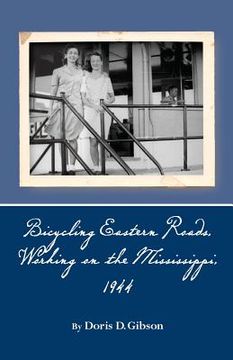Synopsis "Bicycling Eastern Roads, Working on the Mississippi, 1944 (in English)"
The backdrop for this amazing bicycle trip was World War II and before that, the decade of the Great Depression. In the 1930s, most people were in the throes of managing their lives with the smallest of incomes, or no income. Everyone was touched by this bare and dismal decade. We began to emerge from this dark period because of the events taking place in Europe and later in Japan. Hitler was on the march in Europe and the non-belligerent countries such as England and France were almost defenseless. The United States passed a series of Acts, such as the "cash and carry" act and the "lend-lease" act, both of which provided wartime supplies to these countries. When we entered the war in Europe and when Pearl Harbor was attacked, all men between the ages of 18 and 45 were called up for military service. The demographics of the United States changed. All factories were crowded with machines; workers were in demand; and tanks, planes, and weapons were being sent for warfare. It was an abrupt change from the 1930's. The mood of the people was lightened when the Depression was over. There was a spirit of cooperation and a feeling of unity. Everyone was patriotic. When the two girls in this memoir, Doris and Poppy, bicycled up to a farmer's door and requested a night in his barn, there was no hesitation. Only one question was asked, "Do you smoke?" This was a trusting society. Doris and Poppy packed their blue Victory bikes and traveled from their homes in Buffalo, New York, through the level farmland of western New York State, Pennsylvania, Ohio. Part I of this book is titled "On the Road," and follows the girls to Lakeview and Fredonia in New York State and then to Johnny Philips' farm in Pennsylvania, where they met up with a friendly hobo. From Erie, Pennsylvania they biked to Cleveland, Ohio. All they brought with them were the simplest of supplies, a mess kit, a canteen, and a blouse and skirt to wear on Sundays. Each person they met had a part to play in this panorama of scenes and people. Part I of this book are interspersed with menus and shopping lists excerpted from the girls' logs, showing 1944 prices. They cooked their meals outside, well off the road and under bridges, and they slept wherever they found a safe spot, whether it was in a barn or in a country cemetery. Bicycling diagonally from Cleveland to Cincinnati brought the girls in touch with a number of families and new experiences. To the south, the hills of Kentucky were daunting. They accepted a ride from a driver trucking oranges. During this ride the girls faced their first experience with segregation. Louisville was the end of bicycling in the northern states. The girls applied for temporary union cards to work on a Mississippi riverboat. When the riverboat arrived, they took their bikes aboard and headed down the Ohio and Mississippi rivers to New Orleans. Part II of the book opens when the girls board the riverboat, The Corregidor. The cook put the girls to work, peeling potatoes and shucking corn. In the afternoons, the Captain invited the girls to the pilot house to regale them with stories of the river. There was always drama on the boat; a man gone overboard, a fight in the union meeting, and a love affair intercepted by the First Mate. Excerpts from the Captain's letters to Doris from 1944 to 1947 tell and continue the story of life on the Corregidor. Part III is the story of the girls' trip home from New Orleans to Buffalo. It takes us through the foreboding Coney Island Swamp. It follows the girls into Atlanta, where they are interviewed by the Atlanta Journal. From Atlanta the girls hitch a ride to Washington, D.C., where they bicycle to the U.S. Capitol Building. They are amazed to find themselves on the dome of the Capitol, surrounded by a group of painters. When they return home to Buffalo, the girls' found a Buffalo Evening News reporter waiting for them in the driveway.

